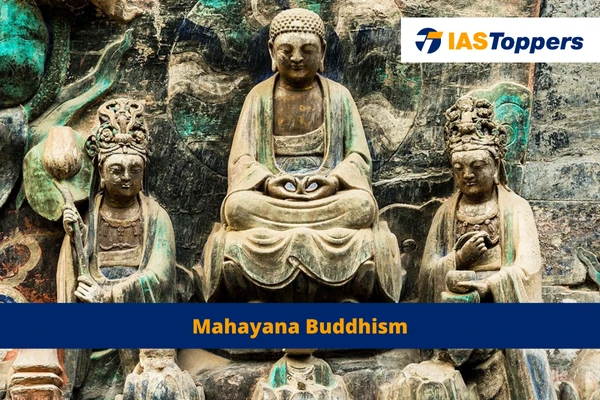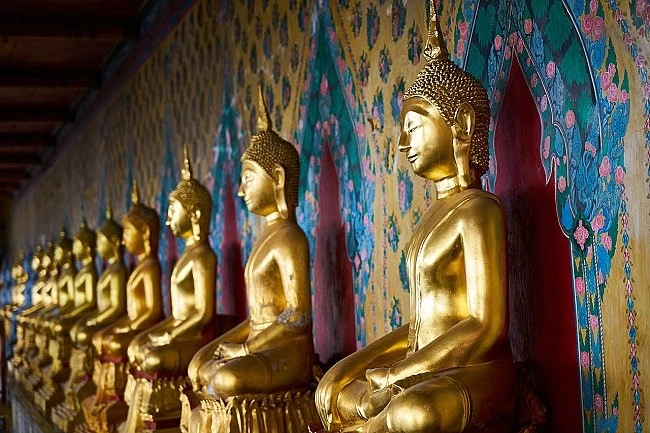Mahayana Buddhism, also known as “The Great Vehicle,” emerged from the Mahasanghika school around 383 BCE. It values the present moment, proposing the omnipresence of enlightened beings. It introduced the concept of trikaya (three bodies) of Buddha, viewing Buddha as a superior, timeless entity. It promotes collective enlightenment through the bodhisattva path, where individuals choose to be born in challenging environments to alleviate human suffering. In this article, you will know meaning and definition of Mahayan Buddhism, its history, beliefs, teachings, practices and scriptures, all of which are important for GS Paper-1 Art & Culture of UPSC IAS Exam.
Table of Content
- Mahayana Buddhism
- History and Origin of Mahayana Buddhism
- Beliefs of Mahayana Buddhism
- Teachings of Mahayana Buddhism
- Mahayana Practices
- Mahayana Scriptures
- Conclusion
- FAQs on Mahayan Buddhism
Mahayana Buddhism
- Mahayana Buddhism is the largest Buddhist sect in the world.
- Mahayana means The Great Vehicle.
- It developed as a school of thought sometime after 383 BCE, potentially from the earlier Mahasanghika school, though that claim has been challenged.
History and Origin of Mahayana Buddhism
- After the Second Buddhist Council in 383 BCE, the early Buddhist faction known as the Mahasanghika (“Great Congregation“) came into being due to doctrinal disputes.
- The lead to the Sthaviravada school (“Elders’ Sect” or “Elders’ Doctrine”) to break away from the main Buddhist community.
- This initial divergence paved the way for the emergence of various Buddhist streams, with Mahasanghika being one among them.
- It was assumed by scholars in the 19th-century that Mahasanghika, claiming to represent the majority of Buddhists, gradually transformed into Mahayana.
- Mahayana Buddhism adopted all Mahasanghika beliefs, adding that the Mahayana sutras – books of Buddhist teachings and meditations – encapsulated the true vision of the Buddha.
- However, modern research suggests that Mahayana and Mahasanghika existed concurrently.
- The Mahayana sect self-proclaimed its dominance in terms of followers and termed other sects as Hinayana, implying them as “The Lesser Vehicle“.
- This label was given to those who rejected Mahayana sutras and had different views about Buddha and his fundamental teachings.
Beliefs of Mahayana Buddhism
- Contrary to the Sthaviravada interpretation of an arhat as an individual seeking spiritual perfection, the Mahasanghika sect viewed an arhat as a spiritual learner who is as flawed as any human and devoid of divine abilities. An arhat was considered a spiritual seeker following Buddha’s teachings for their growth.
- It believes that there are three aspects of Buddhahood, which it describes by regarding Buddha as having three bodies (trikaya):
- Dharmakaya: Buddha is transcendent – he is the same thing as the ultimate truth.
- Sambhogakaya: Buddha’s body of bliss, or enjoyment body.
- Nirmanakaya: Buddha’s earthly body – just like any other human being’s body.
- They believe in the existence of the present moment only, considering past and future as distractions that disturb the mind.
- Enlightened beings, spirits, and deities exist everywhere, at every moment, due to the concept of an eternal present.
- Achieving enlightenment allows individuals to develop exceptional powers, like non-verbal communication.
- Emphasis on Bodhisattva: Unlike other sects, Mahayana Buddhism prioritized the role of the bodhisattva. The path to enlightenment was seen as a collective journey for the benefit of all beings, not just a personal pursuit.
- Bodhisattvas willingly choose to be born in difficult environments to help alleviate human suffering.
- Perception of Buddha: In Mahayana belief, Buddha (Sakyamuni Buddha) is seen as a timeless, superior entity who is either eternal or has an immeasurably long life. By accepting this truth and committing to emulate Buddha’s path, individuals gain spiritual merit, propelling them towards becoming a bodhisattva, and eventually, a Buddha.
- Mahayana Buddhism holds that all Buddhas are omnipresent in the eternal moment of life. According to Mahayana beliefs, Sakyamuni Buddha, like all Buddhas, remains active in the lives of both believers and non-believers worldwide, influencing future generations.
Teachings of Mahayana Buddhism
Understanding Bodhisattva
- The Mahayana Buddhism believes in the concept of Bodhisattva, implying anyone can strive to become a Buddha.
- This idea contrasts with non-Mahayana Buddhism, where only a Buddha before his awakening can be termed as a Bodhisattva.
- Bodhisattvas seek to understand the reality through wisdom (prajna) and compassion (karuna).
- They believe that since no individual has a “self,” there can be no real difference between themselves and others.
Process of Awakening
- Buddhism sess the world as a cycle of reincarnation (samsara) with the possibility of escape through attaining nirvana.
- In Mahayana, the focus is on gaining wisdom, which leads to awakening.
- The concept of emptiness (shunyata) signifies that everything is dependent on other things for its existence, and nothing possesses an essence.
- The ‘Two Truths’ doctrine resolves the conflict by stating things do not exist substantially but are mere conventions.
Infinite Number of Buddhas and Bodhisattvas
- They believe that there are countless buddhas and bodhisattvas.
- These buddhas erases the separation between samsara and nirvana.
- For instance, the bodhisattva Dharmakara promised to create a blissful world and grant ordinary beings’ rebirth through faith in him.
- This development shifted the source of liberation from a sole Buddha to multiple sources.
Doctrine of Skillful Means (Upaya)
- Buddhas and bodhisattvas aim to guide ordinary beings towards liberation through skilful means (upaya).
Monastic and Philosophical Traditions
- Mahayana Buddhism, while introducing various doctrines, is organized as a thoroughly monastic movement.
- There’s a focus on the laity, recognizing that renunciation depends on simultaneous engagement in and nonattachment to the world.
- The traditions in Japan and the Nyingma order in Tibet also feature married clergy alongside celibate monasticism.
- Mahayana philosophical schools like Madhyamika and Yogacara systematize the doctrines of Mahayana scriptures.
Mahayana Practices
Mahayana Buddhism promotes spiritual growth through ten essential practices known as paramita, each playing a crucial role in an individual’s spiritual journey:
- Dana: Charity through generous giving
- Sila: Moral behavior, self-control, and virtuous conduct
- Ksanti: Exercising patience, endurance, and tolerance
- Virya: Persistent effort, diligence, and perseverance
- Dhyana: Concentration, single-mindedness
- Prajna: Compassionate wisdom and spiritual awareness
- Upaya: Effective methods for achieving tasks
- Pranidhana: Resolve and determination toward achieving goals
- Bala: Spiritual power
- Jnana: Knowledge, both of the nature of life and of oneself
These principles vary across different traditions, with some adopting only the first six, while others using all ten. This reflects the diversification of Buddhist thought over time.
Mahayana Scriptures
- In addition to the Dhammapada, the Perfection of Wisdom (Prajnaparamita) forms the core text of Mahayana Buddhism.
- It serves as a manual for becoming a bodhisattva, providing a complete understanding of Buddhist Dharma, devoid of ego-induced ignorance and arrogance.
- Notable segments include the Perfection of Wisdom in Eight Thousand Lines (c. 50 BCE), the Diamond Sutra (c. 2nd century CE), and the Heart Sutra (c. 660 CE).
- Other key texts include the Lotus Sutra that says that all Buddhist forms represent aspects of Ekayana (“One Vehicle” or “One Path”) and the Pure Land Sutras, which praise the Celestial Buddha Amitabha.
- The Golden Light Sutra underscores the significance of internal order reflected externally, specifically regarding rulers and authoritative figures.
- The Tathagatagarbha Sutras propose that all living beings possess a Buddha-nature that, if nurtured, can lead to enlightenment.
Conclusion
Mahayana Buddhism offers a unique perspective on spiritual development, focusing on the collective journey towards enlightenment. It encourages compassion, wisdom, and spiritual growth, using various practices and teachings to guide followers on their path. This diverse and inclusive sect underscores the significance of living in the present moment, nurturing the Buddha-nature within all beings.
Ref: Source-1
| Other Articles in History & Culture | |
| Great Depression | Rock-Cut Architecture |
| Palaeolithic Period | Folk Theatre |
| Indian Handicrafts | Highest Civilian Awards in India |
FAQs (Frequently Asked Questions)
What is Mahayana Buddhism?
Mahayana Buddhism, the world’s largest Buddhist sect, emphasizes compassion and collective enlightenment. Originating from the Mahasanghika school, it introduced the concept of trikaya or three bodies of Buddha and promotes the bodhisattva path, aiming for a collective journey towards enlightenment for the benefit of all beings.
What are the core beliefs and characteristics of Mahayana Buddhism?
Mahayana Buddhism believes in the omnipresence of enlightened beings and the existence of only the present moment. It views Buddha as a superior, timeless entity, and promotes the path of Bodhisattvas who seek to alleviate human suffering. It also underscores the significance of practices known as paramita for spiritual growth.
What is the difference between Hinayana Buddhism and Mahayana Buddhism?
Mahayana Buddhism embraces the concept of Bodhisattvas and multiple Buddhas, focusing on collective enlightenment, while Hinayana (a term considered pejorative, often replaced with Theravada) primarily emphasizes individual enlightenment and reveres only Gautama Buddha.
What are the key features of Mahayana Buddhism?
Key features of Mahayana Buddhism include belief in the Bodhisattva ideal, multiple Buddhas, the Three Bodies of Buddha, the present moment’s importance, and the principle of emptiness. It also focuses on wisdom, compassion, and practices like the Paramitas to attain enlightenment.
Who was the founder of Mahayana Buddhism?
Unlike other religious doctrines, Mahayana Buddhism doesn’t have a specific founder. It gradually evolved from the early Buddhist schools, primarily Mahasanghika, around the 1st century BCE.
What is the difference between Mahayana Buddhism and TheravadaBuddhism?
While Theravada Buddhism emphasizes individual enlightenment and self-discipline, focusing on the historical Buddha and monastic life, Mahayana Buddhism promotes the Bodhisattva ideal, aims for collective enlightenment, and has a broader canon including additional texts and doctrines.
What is the purpose of Mahayana Buddhism?
The purpose of Mahayana Buddhism is to attain collective enlightenment for the benefit of all sentient beings, highlighting the Bodhisattva path, which involves compassion, wisdom, and dedicated practice to achieve Buddhahood.
Why is Mahayana called the great vehicle?
Mahayana is called “the Great Vehicle” because it’s viewed as a more comprehensive and inclusive path to enlightenment, aimed at carrying all beings toward spiritual liberation, emphasizing the Bodhisattva ideal.
What is thefundamental difference between Mahayana buddhism, Hinayana buddhism and Theravada Buddhism?
Mahayana Buddhism focuses on the Bodhisattva path and collective enlightenment. Hinayana (often replaced with Theravada due to pejorative connotations) emphasizes individual enlightenment and monastic discipline, focusing on the historical Buddha. Theravada is seen as more conservative, preserving the earliest teachings, while Mahayana introduces additional doctrines and texts.



